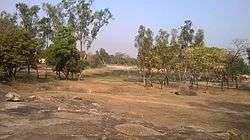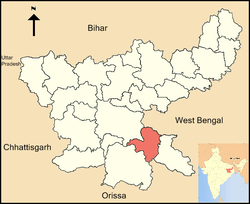Seraikela Kharsawan district
Seraikela-Kharsawan district or Saraikella and Kharaswan district:[1] formerly the Odia princely states of Seraikela and Kharaswan is one of the twenty-four districts of Jharkhand state in eastern India. Seraikela town is the district headquarters of Saraikela Kharsawan district . The district is well known for Seraikela Chhau, one of the three distinctive styles of the chhau dance. This district was carved out from West Singhbhum district in 2001.
Seraikela-Kharsawan district | |
|---|---|
District of Jharkhand | |
 | |
 Location of Seraikela-Kharsawan district in Jharkhand | |
| Country | India |
| State | Jharkhand |
| Division | Kolhan division |
| Headquarters | Seraikela |
| Government | |
| • Lok Sabha constituencies | 1. Ranchi (shared with Ranchi district, 2. Singhbhum (shared with West Singhbhum district and 3. Khunti (shared with Khunti district) |
| • Vidhan Sabha constituencies | 3 |
| Area | |
| • Total | 2,724.55 km2 (1,051.95 sq mi) |
| Population (2011) | |
| • Total | 1,065,056 |
| • Density | 390/km2 (1,000/sq mi) |
| • Urban | 16.30% |
| Demographics | |
| • Literacy | 68.85 per cent |
| • Sex ratio | 958 |
| Time zone | UTC+05:30 (IST) |
| Average annual precipitation | 1350 mm |
| Website | http://seraikela.nic.in/ |
History
| Year | Pop. | ±% p.a. |
|---|---|---|
| 1901 | 190,062 | — |
| 1911 | 212,210 | +1.11% |
| 1921 | 224,453 | +0.56% |
| 1931 | 274,259 | +2.02% |
| 1941 | 327,053 | +1.78% |
| 1951 | 355,319 | +0.83% |
| 1961 | 413,188 | +1.52% |
| 1971 | 493,874 | +1.80% |
| 1981 | 560,359 | +1.27% |
| 1991 | 707,175 | +2.35% |
| 2001 | 848,850 | +1.84% |
| 2011 | 1,065,056 | +2.29% |
| source:[2] | ||
Royalty
Members of the erstwhile royal family of Seraikella, the Singh Deo family (patrons of the Chau dance), divide their time between The Palace, Seraikella-833219; a 300-year-old heritage palace and historical landmark and their residences in Odisha, West Bengal and abroad. The last ruler of the Seraikella princely state was HH Raja Aditya Pratap Singh Deo (son of HH Maharaja Udit Narayan Singh Deo) and notables of the era include his sons Tikayet Sahib Nrupendra Narayan Singh Deo, HH Maharaja Sir Rajendra Narayan Singh Deo (given in adoption to Patna-Bolangir state, former Chief Minister of Odisha), Patayet Sahib Maharaj kumar Bhoopendra Narayan Singh Deo (leading regional politician who supported the popular tribal anti-merger movement with Bihar) and Rajkumar Sudhendra Narayan Singh Deo (Param-Guru of Chau), a Padma Shree awardee.
The Singh Deo royal family remains active in public life (political, cultural and religious) and act as guardians to the Ma Paudi temple located within the royal residence, host the annual Chau Festival at the Seraikella Royal Palace and retain a hold on the region's real-estate and business. Despite their loss of formal title and privileges, they enjoy public support in the area (comprising the former Seraikella state). Notable members of the royal family who remain active in the public eye include Rajkumar Pratap Aditya Singh Deo, Rajkumar Juga Bhanu Singh Deo, Maharajkumar Jairaj Singh Deo and Rajkumar Rajvikram Singh Deo. The District of Seraikella and Kharsawan was formed on 1 April 2001 after being separated from West Singhbhum district.
Recent events
The district is currently a part of the Red Corridor.[3]
Geography
The district is situated between 22°29'26" and 23°09'34" north latitudes and 85°30'14" and 86°15'24" east longitudes.
Rivers and lakes
Several rivers flow across Seraikela Kharsawan district. Among these Subarnarekha, Kharkai, Korkori are the important ones. Chandil dam is one of the popular and famous waterbodies of the district. It is located near the chandil town.[4]
Economy
In 2006 the Ministry of Panchayati Raj named Seraikela Kharsawan one of the country's 250 most backward districts (out of a total of 640).[5] It is one of the 21 districts in Jharkhand currently receiving funds from the Backward Regions Grant Fund Programme (BRGF).[5]
Administration
Blocks/Mandals
Seraikela Kharsawan district consists of 09 Blocks. The following are the list of the Blocks in Seraikela Kharsawan district:
1 Seraikela, 2 Kharsawan, 3 Gamharia, 4 Kuchai, 5 Ichagarh, 6 Nimdih, 7 Chandil, 8 Rajnagar, 9 Kukru
Divisions
There are three Vidhan Sabha constituencies in this district: Ichagarh, Seraikela and Kharsawan. These are parts of Ranchi, Singhbhum and Khunti Lok Sabha constituencies respectively.
Demographics
According to the 2011 census Seraikela Kharsawan district has a population of 1,065,056,[6] roughly equal to the nation of Cyprus[7] or the US state of Rhode Island.[8] This gives it a ranking of 428th in India (out of a total of 640).[6] The district has a population density of 390 inhabitants per square kilometre (1,000/sq mi) .[6] Its population growth rate over the decade 2001-2011 was 25.28%.[6] Saraikela Kharsawan has a sex ratio of 958 females for every 1000 males,[6] and a literacy rate of 68.85%. 35.2% of the population are from Scheduled Tribes and 5.3% from Scheduled Castes.[6]
At the time of the 2011 Census of India, 44.01% of the population in the district spoke Bengali, 15.62% Santali, 9.65% Ho, 9.48% Odia, 6.98% Hindi, 4.76% Mundari, 2.85% Kurmali, 2.83% Urdu, 2.7% Bhojpuri and 1.05% Maithili as their first language.[9]
References
- (PDF) http://odisha.gov.in/e-magazine/Orissareview/2011/Apr/engpdf/31-34.pdf. Cite journal requires
|journal=(help); Missing or empty|title=(help) - Decadal Variation In Population Since 1901
- "83 districts under the Security Related Expenditure Scheme". IntelliBriefs. 2009-12-11. Retrieved 2011-09-17.
- "District at a Glance".
- Ministry of Panchayati Raj (September 8, 2009). "A Note on the Backward Regions Grant Fund Programme" (PDF). National Institute of Rural Development. Archived from the original (PDF) on April 5, 2012. Retrieved September 27, 2011.
- "District Census 2011". Census2011.co.in. 2011. Retrieved 2011-09-30.
- US Directorate of Intelligence. "Country Comparison:Population". Retrieved 2011-10-01.
Cyprus 1,120,489 July 2011 est.
- "2010 Resident Population Data". U. S. Census Bureau. Retrieved 2011-09-30.
Rhode Island 1,052,567
- 2011 Census of India, Population By Mother Tongue